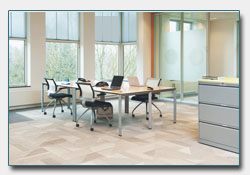Verna Lynch
Sr. VP Business Development
September 26, 2014 | 2:30 PM ET

In our work here at TBI, we spend most of our time helping organizations plan, implement, and maintain large, strategic, and complex initiatives. However, sometimes big things can come in simple packages. I was having lunch with a friend last week and the discussion got around to work spaces and how they can impact productivity and motivation, whether in an office environment, manufacturing environment, or somewhere in between. Her employer, a large professional services firm, had recently expanded its work space, and her group had been moved to a different work space. She reported that she was amazed at how much better and more productive the entire work situation had become.
Before the move, the work group had been crammed into a too-small space which was also near a door, by a walkway, near a printer/copier workspace. Each person had a cubicle that had been made as private as possible; but the cubicles were small, the atmosphere was noisy, interruptions were frequent, and there is no disputing that walking through there could make you claustrophobic.
After the move, my friend marveled at how much better productivity and morale are. The group was no longer housed in a loud, heavy-traffic area. Each person now had workspaces in which they could actually get their jobs done and have the materials they needed.
This double benefit — increased productivity and employee satisfaction — should be no surprise. Herzberg taught us about motivation at work and the role of the physical environment. Not only does the work environment play a role in productivity and morale in business office or research environments, it plays a role in manufacturing workplaces as well.
In various improvement projects over the years in manufacturing environments, I learned how quickly productivity improved by getting the work space cleaned up and more orderly. In one location, we had a long-term plan of implementing long-term, cross-functional process improvement teams. To set the stage for the later initiative, we put together short term, temporary “blitz teams” to improve the physical environment. Within weeks, not only had productivity improved, but also morale. Why?
- The work space was now more organized. How much time do you waste each day looking for things? 10 minutes a day equals more than one work-week per year.
- The messes in the work space were eliminated, allowing better workflow and productivity.
- People felt like they could gain better control of their work lives by reducing obstacles and interruptions.
- People felt like they were being heard. (In the case of the manufacturing projects referred to above, the workers participated in the planning and improvement. However, in the case of some work environment, the improvement was largely planned by someone else, although some input was solicited from the employees working in the space, as they arranged the workspace once they were relocated.)
- The new workspace prompted the groups to set up new “ground rules” for behaviors that would contribute to improved work.
- They put their energy into getting rid of some of the obstacles that had undermined their work for a long time.
- Ideas were put in place to keep the workplaces more organized.
If you’re serious about improving productivity and morale and you’re looking for things to do that can help you progress quickly, improving the work space is a good place to start in your longer-term productivity improvement initiatives.
For more information about TBI’s services please contact TBI or you can reach us at:
201.573.0400.

